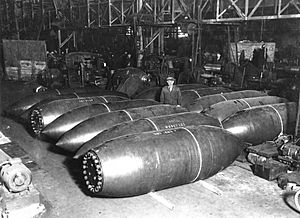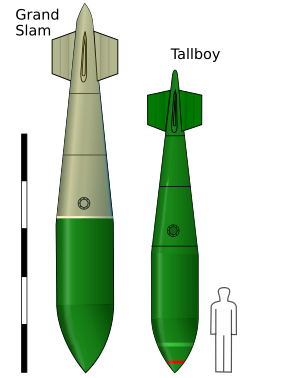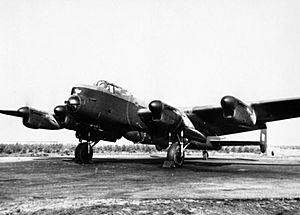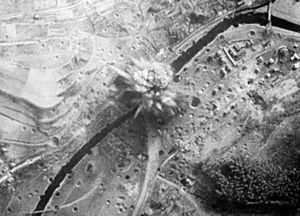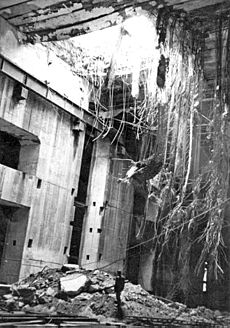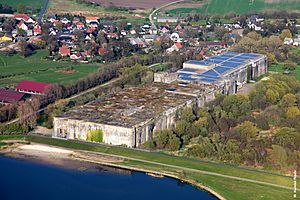Grand Slam (bomb) facts for kids
Quick facts for kids Grand Slam |
|
|---|---|

A Grand Slam bomb being handled at RAF Woodhall Spa in Lincolnshire
|
|
| Type | Earthquake bomb |
| Place of origin | United Kingdom |
| Service history | |
| In service | 1945 |
| Used by | Royal Air Force |
| Wars | Second World War |
| Production history | |
| Designer | Barnes Wallis |
| Designed | 1943 |
| Manufacturer | Vickers, Sheffield Clyde Alloy/Steel Company of Scotland, Blochairn, Glasgow |
| Produced | 1944–1945 |
| No. built | 42 used, 99 built by Clyde Alloy and the A. O. Smith Corporation of America
|
| Variants | M110 (T-14) 22,000-lb GP Bomb (United States) |
| Specifications | |
| Mass | 22,000 lb (10,000 kg) |
| Length | 26 ft 6 in (8.08 m) |
| length | Tail 13 ft 6 in (4.11 m) |
| Diameter | 3 ft 10 in (1.17 m) |
|
|
|
| Filling | Torpex D1 |
| Filling weight | 9,500 lb (4,300 kg) |
|
Detonation
mechanism |
penetration: earth 40 m (130 ft); concrete 6 m (20 ft) |
| Blast yield | 6.5 long tons (6.6 t) TNT equivalent |
The Grand Slam was a huge 22,000 lb (10,000 kg) (about 10,000 kg) earthquake bomb used by the RAF during the final part of World War II. It was designed to cause damage by shaking the ground, not just by exploding on the surface. This special bomb was created by Barnes Wallis, who also invented the famous Tallboy bomb. The Grand Slam was like a much bigger version of the Tallboy.
These "Medium Capacity" bombs were built to be very strong and could go deep into the ground or through tough structures before exploding. This made them much more powerful than regular bombs. The Grand Slam's outer shell was made from a special metal called chrome-molybdenum alloy steel.
Regular Avro Lancaster planes couldn't carry such a heavy bomb. So, 32 special Lancaster bombers were built. These planes had stronger landing gear and more powerful engines. They also had their bomb bay doors removed and many other parts taken out to make them lighter. When carrying a Grand Slam, these special Lancasters were hard to fly and couldn't move easily. If a plane had to return with its bomb, it had to land on a very long runway at RAF Carnaby instead of its usual base.
From March to April 1945, 42 Grand Slams were dropped on targets in Germany. These bombs were designed to hit soft ground, dig deep, and then explode underground. This created a huge underground crater, making the buildings above collapse. Grand Slams and Tallboys caused damage that smaller bombs couldn't. They helped speed up the end of the war and avoided harming many civilians. These bombs were the most effective weapons the Allies had until nuclear weapons were developed later that year. After the war, the RAF and the United States Army Air Forces used Grand Slams for research.
Contents
How the Grand Slam Bomb Was Designed
Stronger Bombs for Tough Targets
During World War II, engineers wanted to make bombs that could do more damage. Regular bombs, called "General Purpose" (G.P.) bombs, didn't have enough explosive power compared to their weight. They also weren't strong enough to break through very tough targets.
So, "Medium Capacity" (M.C.) bombs like the Grand Slam were created. These bombs had a lot more explosive inside. Their outer shells were also much stronger. This allowed them to penetrate deep into the ground or through thick concrete. This made them very effective against strong enemy buildings.
The Idea for the Grand Slam
After a famous raid on German dams in 1943, the British government asked for bigger bombs. They wanted a "Tallboy Large" bomb, which was later renamed the Grand Slam in 1944. This happened after the name "Tallboy" appeared in newspapers.
Experts learned that the original Tallboy bomb wasn't big enough to destroy very strong concrete buildings with a direct hit. It only worked well if it exploded underground nearby. This made them realize a much bigger bomb was needed. Also, Germany started attacking London with V-2 rockets. The Grand Slam was considered a weapon to destroy the V-2 launch sites.
At first, some people in the British Air Ministry doubted if the Grand Slam was really needed. They wondered if there would be any targets left by the time it was ready. But others, like Air Commodore Christopher Bilney, believed it would be very useful. The head of Bomber Command, Air Marshal Sir Arthur Harris, thought it would be good against U-boat pens and other large targets.
The decision was made to build the new bombs. An order for 600 was placed, but later changed. Eventually, 25 bombs were made in Britain and 200 in the United States.
Building the Giant Bomb
Making a bigger version of the Tallboy design wasn't possible. So, a new design was needed. A company in Sheffield, England, started working on the huge bomb casings. They experimented with a special steel alloy made of chromium and molybdenum. This metal had to be strong enough to handle the shock when the bomb hit its target.
To make the casing, a very precise concrete core was created. Then, molten metal was poured around it. After the metal cooled, the core was chipped out. If there were any hot spots on the casing during cooling, it could create weak spots. This might cause the bomb to break apart on impact without exploding. All bombs had to pass tough tests to make sure they were strong enough.
The front part of the bomb, which was about 12.1 ft (3.7 m) long, was filled with 9,200 lb (4,200 kg) of Torpex explosive. Once the tail was attached, the Grand Slam was about 25.5 ft (7.8 m) long. It was 3.10 ft (0.94 m) wide and weighed about 22,400 lb (10,200 kg). Like the Tallboy, the Grand Slam's fins were angled. This made the bomb spin as it fell, which helped it fly straight. The bomb had four different fuses, some with long delays, like 11 seconds or even up to 144 hours.
The Special Lancaster Bombers
To carry the Grand Slam, special versions of the Lancaster bomber were needed. These planes were called Lancaster B.Mk 1 (Special). Building these special planes meant fewer regular Lancasters could be made.
The B.Mk 1 (Special) planes had many parts removed to save weight. This included the front and middle gun turrets, some fuel tanks, and other equipment. The crew was also reduced to five men. The bomb bay doors were removed because the Grand Slam was too big to fit with them.
These special Lancasters were very heavy when carrying a Grand Slam. They couldn't make quick turns or sudden movements. Pilots were told to let the aircraft "wallow" (move slowly from side to side) rather than trying to correct it too much. The planes were also painted in a special camouflage for daytime bombing.
Testing the Grand Slam
First Test Drop
The first Grand Slam bomb arrived at RAF Woodhall Spa in January 1945. The RAF only had one bomb for testing, while 617 Squadron waited with the rest, ready for missions.
The test happened at the Ashley Range in the New Forest. The target was a concrete area. On March 13, 1945, a special Lancaster, PB592/G, successfully dropped the bomb. The bomb was painted black and white so observers could see it. It spun as it fell, hitting the ground slightly off target.
After being released, the Grand Slam sped up to almost the speed of sound. It dug deep underground before exploding. The explosion created a huge crater, 124 ft (38 m) wide and 34 ft (10 m) deep. This test was a big success, and formal permission to use the bomb in combat was given on March 22.
Grand Slam Missions in 1945
Bielefeld Viaduct, March 14
By March 1945, the Bielefeld viaduct had been attacked many times. On March 14, fifteen Lancasters from 617 Squadron, carrying 14 Tallboys and one Grand Slam, attacked it again. The weather was clear.
The Grand Slam was dropped from PD112 'S' at 11,965 ft (3,647 m). It hit the ground about 30 yd (27 m) short of the target and exploded. The explosion was so powerful that the plane jumped 500 ft (150 m) higher from the sudden loss of weight. The Grand Slam and Tallboys destroyed about 200 ft (61 m) of the north viaduct and 260 ft (79 m) of the south viaduct. This left about 20,000 long tons (20,000 t) of rubble in the valley below.
Arnsberg Viaduct, March 15 and 19

On March 15, two Grand Slams were used against the Arnsberg railway viaduct. Visibility was poor due to haze. The first Grand Slam was dropped, but the second had to be brought back because of the haze. No direct hits were seen, and no aircraft were lost.
On March 19, 617 Squadron attacked the Arnsberg viaduct again. This time, six Lancasters carried Grand Slams and 13 carried Tallboys. One Grand Slam hit the western part of the viaduct, causing it to break apart. Two spans of the bridge, about 100 ft (30 m) long, were destroyed. After the war, a Grand Slam casing was found at the site. It was believed to have landed flat and only partly exploded.
Arbergen Bridge, March 21
On March 21, twenty Lancasters from 617 Squadron, two with Grand Slams, attacked the railway bridge at Arbergen near Bremen. The weather was good.
The first Grand Slam landed 30 yd (27 m) short of the target. The second one missed by 200 yd (180 m) due to anti-aircraft fire. However, the Tallboys hit the middle of the bridge, causing it to collapse. One Lancaster was shot down, and five others were damaged by anti-aircraft fire or jet fighters.
Nienburg Bridge, March 22
The next day, March 22, twenty Lancasters from 617 Squadron, six with Grand Slams, attacked the railway bridge at Nienburg. The conditions were perfect for bombing.
The bombers dropped five Grand Slams and twelve Tallboys. One pilot reported, "The first large bomb hit the bridge... and blew the bridge up. It collapsed in the water." Reconnaissance photos later confirmed the bridge was destroyed.
Bremen Bridge, March 23
Another railway bridge near Bremen was attacked on March 23. Six Lancasters carried Grand Slams. The weather was clear, but German anti-aircraft defenses were strong.
Two hits were seen before smoke blocked the view. One Grand Slam had to be dropped in a safe area because of engine trouble. Another Lancaster's bomb aimer panel was smashed by anti-aircraft fire, but the pilot decided to bomb anyway. Later analysis showed that a Tallboy hit the river bank, and the shock caused a bridge span to fall into the river. The Germans eventually destroyed the bridge themselves to block the Allied advance.
Farge U-boat Pens, March 27
On March 27, 617 Squadron attacked the Valentin submarine pens at Farge. These were huge, strong concrete shelters for U-boats. The roof was about 15 ft (4.6 m) thick and was being made even thicker.
Thirteen Lancasters carried Grand Slams. Two Grand Slams and one Tallboy hit the un-thickened part of the roof. The Grand Slams went 8 ft (2.4 m) into the concrete. They caused about 1,000 long tons (1,000 t) of the roof to fall in, bringing down two large cranes. People inside the pens reported a huge shockwave. No aircraft were lost during this mission.
Hamburg U-boat Pens, April 9
On April 9, 617 Squadron attacked the Finkenwerder U-boat pens in Hamburg. These pens had a roof 11.5 ft (3.5 m) thick. Two Lancasters carried Grand Slams.
The weather was clear. German jet fighters and heavy anti-aircraft fire tried to stop the attack. Six Lancasters were damaged. Reconnaissance photos showed seven hits, with four bombs going through the roof. Six Tallboys hit the roof, causing holes and dropping tons of concrete into the pens. About 27 people inside were killed, and many were injured. German U-boats were also damaged.
Heligoland Coastal Batteries, April 19
On April 19, the coastal gun batteries on the islands of Heligoland were attacked. These batteries had large guns and radar. The goal was to silence them so Allied ships could safely enter nearby rivers.
Twenty Lancasters from 617 Squadron attacked with six Grand Slams and fourteen Tallboys. The attack was made in two waves. There was very little anti-aircraft fire. Photographic evidence showed two direct hits and several near misses. This added to the damage already caused by previous raids. The war ended before another attack was needed.
After the War
Research and Testing
After the war, in March 1946, the British and US forces started a project called "Operation Front Line" (or "Project Ruby"). They wanted to study how well penetration bombs worked against strong concrete targets. The Valentin submarine pens near Bremen, which had been attacked by Grand Slams, were chosen for these tests.
In May 1946, US B-29 bombers joined the tests. They dropped Tallboys and Grand Slams on the Valentin pens and Heligoland. However, only two hits were achieved out of thirteen attempts. Reports from both the RAF and USAAF concluded that the bombs weren't as effective as hoped against reinforced concrete. They suggested more tests.
Later, new US bombs, the Amazon II and Samson, both 25,000 lb (11,000 kg), were also tested. Photographs taken before the war's Grand Slam attack were used to mark the targets. On August 4, B-29s achieved six hits with 1,650 lb (750 kg) bombs and five hits with Amazon II bombs.
Where to See Grand Slams Today
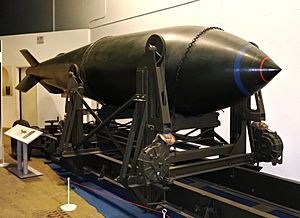
Today, five Grand Slam bombs are preserved in Britain. You can see them at the Royal Air Force Museum London, Brooklands Museum, RAF Lossiemouth, Dumfries and Galloway Aviation Museum, and the Battle of Britain Memorial Flight Visitors' Centre at RAF Coningsby.
You can also see parts of Grand Slam casings (without their tails) at the Kelham Island Museum in Sheffield and the Yorkshire Air Museum at Elvington. The T-12 Cloudmaker is an American version of the Grand Slam, and an example is displayed at the Air Force Armament Museum in the United States.
See also
- Bunker buster
- FAB-9000
- T-12 Cloudmaker
- Thermobaric weapon


